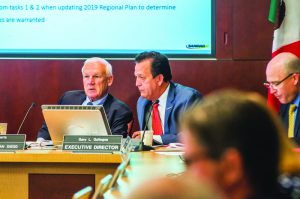Heads Must Roll at SANDAG
Art Castañares / Publisher and CEO

A powerful series of stories written by our media partner Voice of San Diego has revealed how San Diego’s regional planning agency deceived voters (and probably some of its board of elected officials) by knowingly hiding the true impact of a voter-approved sales tax measure aimed at funding highway and public transit projects in our county.
The San Diego Association of Governments, known as SANDAG, is governed by a board of elected officials from each city in the county, as well as by members of the County Board of Supervisors. Together, this board directs its staff of experienced transportation professionals that control billions of dollars in local, state, and federal funding for roads, freeways, public transit, and even bicycle paths throughout San Diego.
But, the investigative stories have revealed that SANDAG has lied to the public for at least the past 13 years when it first became aware that the projections of sales tax revenues from its sales tax increase would fall short of its estimates.
Now, as with all coverups, it has become a question of who knew what and when did they know it.
In 1987, voters approved an initial half-cent sales tax for 20 years to fund regional transportation. By 2004, that tax, known as TransNET, had already generated over $3.3 billion in taxes. Eager to continue the stream of money for more projects, in 2004 SANDAG proposed a 40-year extension to TransNET that went on the ballot in November 2004 as Proposition A. Prop A needed at least two-thirds of voters to support the new tax. In the end, the measure passed with only 4,190 votes to spare out of over a million votes cast in that election.
Then fast forward to 2016 when SANDAG put another 40-year TransNET measure on the ballot to add an additional half-cent tax on top of the current 2004 measure.
The 2016 measure would have raised the total countywide transportation sales tax to one-cent, and was estimated to have raised an additional $18 billion over the next 40 years.
San Diegans weren’t buying it and voted down the measure during our last election in November 2016. Only 57 percent of voters supported the measure and it fell short of the two-thirds vote threshold.
Just weeks after that election in November, however, news broke that the revenue projections SANDAG used to convince voters to support the new TransNET were overstated, or put plainly, dead wrong.
But that wasn’t the worst part. SANDAG then admitted that the same flawed revenues projections were used to estimate the 2004 TransNET tax revenues and admitted that the 12-year-old tax hadn’t raised the amount of money they expected.
It quickly became apparent that SANDAG knew about the erroneous projections before the 2016 election but they failed to tell voters before the election. It started to look like SANDAG was hoping to use the new tax revenues to backfill the promises made to voters in 2004, and, when the new tax failed, the wheels fell off the wagon, so to speak.
Fingers were pointed at a former staff economist as the one that produced the flawed projections, and the Board hired a law firm to investigate how the errors were made. For the last six months, no one has explained who knew what and when they knew it.
Now, this week, Andrew Keates of the Voice of San Diego, reported that SANDAG and its Board knew their projections were flawed back before the 2004 election. This week’s cover story exposes how the Board approved lower projections for the 2004 TransNET nearly a year before the election, but didn’t tell voters.
And why would they not tell voters? Because less money meant fewer projects would be funded, and that could have eroded voter support. Remember, the 2004 measure only passed by 4,190 votes, or only 0.4 percent of the vote. Telling voters the truth could have tanked the tax increase, and would’ve reduced funding for SANDAG, and risked its future as a regional planning agency.
Combined with the revelations that SANDAG misled voters during last year’s election too by overstating those projected revenues, as well as not disclosing an $8 billion dollar increase in construction costs for current projects, SANDAG seems to have tricked voters for over a dozen years by using false data.
Who’s to blame? The elected officials that serve on the SANDAG board, many of which have been on the Board since before the 2004 TransNET? Or Gary Gallegos, SANDAG’s long-serving Executive Director that pulls down over $404,000 a year, more than the President of the United States? Even if they fire him today, his taxpayer-funded pension will probably still net him over $300,000 a year for the rest of his life.
This was not an innocent comedy of errors, but, instead, a systematic ploy to hide the truth from the public. These are public employees paid to serve our community, and instead, they seem to think they are running their own little world of building blocks, using our tax money as their piggy bank.
SANDAG’s highway signs tout their use of TransNET with the slogan “Keep San Diego Moving”.
Now, heads must roll at SANDAG to keep San Diego moving forward with honest, transparent leadership that voters can trust to continue planning San Diego’s way of life.


 Arturo Castañares
Arturo Castañares


